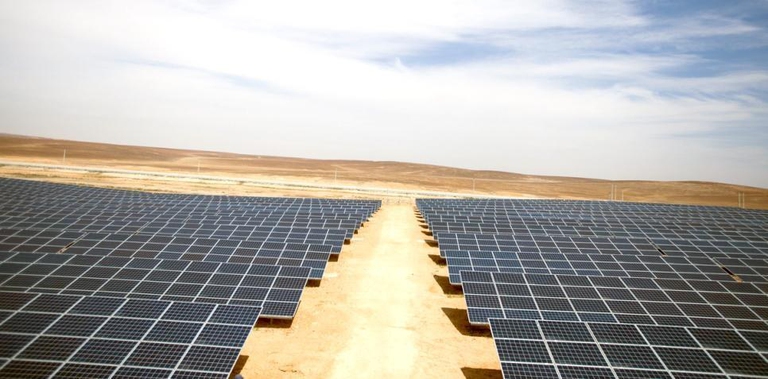
The Louise Michel is the humanitarian rescue ship saving lives in the Mediterranean. Financed by the artist Banksy, it has found a safe port in Sicily.
The solar plant in Jordan’s Azraq refugee camp has started to produce energy, allowing Syrian refugees in the camp to have electricity in their tents. It’s the world’s first refugee camp to be powered by renewable energy: a 2MW plant managed by the UNHCR and financed thanks to the Brighter Lives for Refugees campaign launched
The solar plant in Jordan’s Azraq refugee camp has started to produce energy, allowing Syrian refugees in the camp to have electricity in their tents. It’s the world’s first refugee camp to be powered by renewable energy: a 2MW plant managed by the UNHCR and financed thanks to the Brighter Lives for Refugees campaign launched by the IKEA Foundation.
The solar panels will provide energy to about 20,000 refugees who will be now able to power fridges, TVs, and fans, but also to have light in their accommodations and charge their phones, which are essential for them to keep relations with their relatives abroad.
It’s the first plant of its kind installed in a refugee camp. “Today marks a milestone,” said Kelly T. Clements, UNHCR Deputy High Commissioner. “Lighting up the camp is not only a symbolic achievement; it provides a safer environment for all camp residents, opens up livelihoods opportunities, and gives children the chance to study after dark. Above all, it allows all residents of the camps to lead more dignified lives”. People’s everyday life in Azraq camp is arduous. Located in a desert area in northern Jordan, the camp faces extreme weather conditions. Electricity in Jordan is extremely expensive and in case of shortages some of the simplest activities become hard work: cooking, washing clothes, studying, and walking safely to the bathrooms during night-time hours, especially for women and children.
An exciting launch delivering #cleanenergy, cost-savings + most importantly dignity, job creation, safety + more for refugees. #solar pic.twitter.com/Az4x21yfb5
— UN Refugee Agency (@Refugees) 23 maggio 2017
The access to electricity will change the lives of the refugees who have been living in the camp since 2014, when it was established. Also, the plant will allow saving up to 1.5 million dollars each year and cutting CO2 emission by 2,370 tonnes. The aim is achieving up to 5MW of installed capacity in order to meet the entire camp’s energy needs. Being connected to the national grid, unused electricity generated will be given to local communities, at no cost. “The world’s first solar farm in a refugee camp signals a paradigm shift in how the humanitarian sector supports displaced populations,” said Per Heggenes, CEO of the IKEA Foundation.
“We are very grateful to everyone involved – especially the IKEA customers and co-workers who took part in the Brighter Lives for Refugees campaign, the UNHCR, the Jordanian government, EDCO, and most of all, the Syrian and Jordanian people who made this project a reality”.
Siamo anche su WhatsApp. Segui il canale ufficiale LifeGate per restare aggiornata, aggiornato sulle ultime notizie e sulle nostre attività.
![]()
Quest'opera è distribuita con Licenza Creative Commons Attribuzione - Non commerciale - Non opere derivate 4.0 Internazionale.
The Louise Michel is the humanitarian rescue ship saving lives in the Mediterranean. Financed by the artist Banksy, it has found a safe port in Sicily.
Venezuelan refugees are vulnerable to the worsening outbreak in South America: while coronavirus doesn’t discriminate, it does affect some people more than others.
In the midst of India’s coronavirus lockdown, two dozen people lost their lives in a desperate bid to return home: migrant labourers forced to leave the cities where they worked once starvation began knocking at their doors.
Behrouz Boochani returned to being a free man during the course of this interview. The Kurdish writer was imprisoned by the Australian government in Papua New Guinea for six years.
The Global Compact for Safe, Orderly and Regular Migration was signed by 164 nations in Marrakech. This is what the non-binding agreement that encourages international cooperation stipulates.
The winners of the World Press Photo 2019 tell the stories of migrants in the Americas. From the iconic image of a girl crying on the border between Mexico and the United States to the thousands of people walking from Honduras towards a better life.
The Semìno project is a journey of discovery through different countries’ food habits, offering migrants employment opportunities and allowing us to enjoy the properties of vegetables from all over the world.
Travelling across the new route used by migrants to cross the Balkans and reach Trieste in Italy, a reportage that documents the social, economic and political changes of the countries along the way.
The countries hosting the most refugees aren’t the wealthy, Western ones. An overview by NGO Action Against Hunger reminds us that refugees and internally displaced people are far from being safe.








